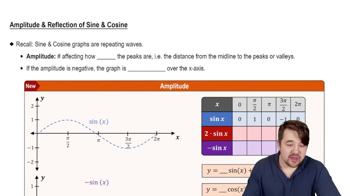Decide whether each statement is true or false. If false, explain why.
The graph of y = sec x in Figure 37 suggests that sec(-x) = sec x for all x in the domain of sec x.
 Verified step by step guidance
Verified step by step guidance Verified video answer for a similar problem:
Verified video answer for a similar problem:



 5:53m
5:53mMaster Graph of Sine and Cosine Function with a bite sized video explanation from Patrick
Start learning